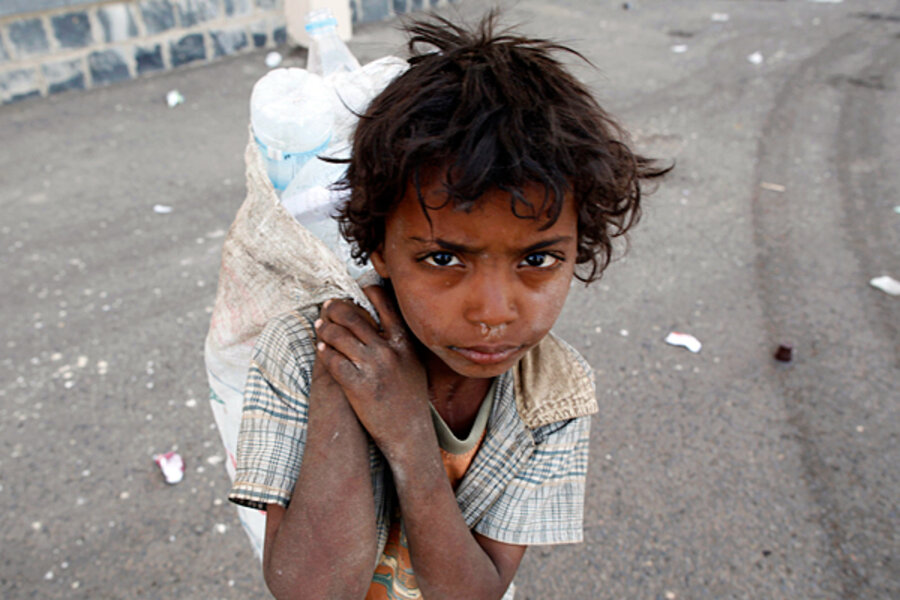US eager to send foreign aid to Yemen, a land battling poverty and Al Qaeda
Loading...
| Sanaa, Yemen
As the dust settles on a year of popular revolt in Yemen, international actors are looking to shore up the new president as he tackles long-standing humanitarian and security problems – not least of all, one of the world’s most worrisome Al Qaeda franchises.
One-third of Yemen’s population is going hungry, 500,000 children are reportedly at risk of dying of malnutrition, 45 percent of the population lives on less than $2 a day, and studies have projected that the capital’s wells will run dry by 2015 as the arid country taxes its modest water resources.
Meanwhile, the deterioration of security in Yemen has created an opening for Al Qaeda in the Arabian Peninsula (AQAP), which has twice attempted to blow up US-bound planes in the past several years. Among Western nations, foreign assistance is seen as a means of countering such extremism.
“The United States is going to have a very important role in trying to help Yemen undertake the necessary reforms as well to provide the assistance that’s going to allow them to move forward economically,” says Gerald Feierstein, US ambassador to Yemen, in an interview.
But Yemen, with its weak government institutions and entrenched corruption, has a history of struggling to effectively absorb aid. Providing too much aid too fast can have devastating consequences, as the West’s 10-year experience in Afghanistan has demonstrated.
So while international players, from the US to the International Monetary Fund, are eager to send assistance, Yemeni politicians are cautioning against creating too much dependency on outside aid – outlining instead a vision of foreign investment.
“Yemen does not need to live on handouts,” says Mohammad Abulahoum, leader of the Justice and Building Party and a prominent Yemeni politician. “If we become a welfare state, we will become a failed state. … Provide Yemen with aid, but then increase investment in the country.”
Of $5.5 billion pledged, only 7 percent spent
The International Monetary Fund has already indicated a willingness to discuss new aid programs in Yemen now that former leader Ali Abdullah Saleh has been removed and the situation is calmer. Other foreign donors are likely to follow suit if Yemen can maintain some degree of stability.
Calculating the level of aid a country can handle predictably varies from place to place, but there are some general indicators for whether aid will succeed.
A study by the Center for Global Development found that when the level of aid approaches 15 to 25 percent of a country’s gross domestic product (GDP) it begins to have diminishing returns. In Afghanistan, where aid and international military spending now account for 97 percent of the nation’s GDP, the World Bank has warned of economic collapse if donors aren’t careful about slowly weaning the country off aid.
“International aid is very critical in the short-term, but I am afraid that in the medium- and long-term it could distort the Yemeni economy,” says Mohammed Al-Maitami, a professor of economics at Sanaa University in Yemen’s capital. “I think the international community today is more aware than before about how to help Yemen in the right way. They have gained a lot of experience in many countries, including Afghanistan, and learned that aid itself can’t make the country sustainable.”
It remains unlikely that a country like Yemen, on the fringes of the international consciousness, will receive extreme levels of aid like those seen in Afghanistan. However, the country has already shown difficulty absorbing even relatively small quantities of assistance.
In 2006, international donors pledged $5.5 billion dollars in assistance to Yemen. Nearly six years later, as little as 7 percent of that money has actually been spent.
'You're pouring a bucket of water into a small bottleneck'
Prior to the year-long uprising, most analysts attributed the failure of the aid to reach its intended sources to a lack of absorptive capacity, corruption, and the government’s failure to prioritize the needs for aid spending. Yemen may have a new president, but it still has yet to eliminate many of the same issues that previously hindered aid spending here.
Jalal Yaqoub, deputy minister of external financial affairs at the Ministry of Finance foresees Yemen facing an imbalance, with more money coming in than the government is able to spend effectively.
“This is exactly what was faced in Iraq. There’s this urgency that was felt by the international community to pour in money to support the country, but, on the other side, the country is not ready to absorb that money, whether it is not politically or not technically ready,” he says. “You’re pouring a bucket of water into a small bottleneck. A lot of the water is going to get spilled and not go into the right areas.”
For now, many in Yemen say the key is taking steps to determine what the country needs, while ensuring that any aid that comes to Yemen lays the foundation for sustainable economic growth.
There is much hope that Yemen can continue to develop its limited oil and gas extraction sector while creating other opportunities for business growth, such as expanding tourism and improving the southern port of Aden so it can handle more shipping traffic. Given effective use of aid and business development, some Yemeni analysts say the country could outgrow the need for foreign assistance in fewer than 10 years.
“What the government has to do right now is prioritize its demands,” says Mohy Al-Dhabbi, prime deputy minister of foreign affairs. “To develop Yemen, we need a plan.”
Get daily or weekly updates from CSMonitor.com delivered to your inbox. Sign up today.





